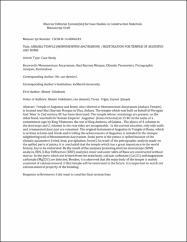| dc.contributor.author | Gökdemir, Ahmet | |
| dc.contributor.author | Demirel, Can | |
| dc.contributor.author | Yeğin, Yavuz | |
| dc.contributor.author | Şimşek, Zeynel | |
| dc.date | 2019-12 | |
| dc.date.accessioned | 2019-12-11T06:57:51Z | |
| dc.date.available | 2019-12-11T06:57:51Z | |
| dc.date.issued | 2015-03-11 | |
| dc.identifier.citation | DEMIREL C.,GÖKDEMIR A.,YEGIN Y., ŞİMŞEK Z. (2015). Ankara Temple Monumentum Ancyranum Temple of Augustus and Rome restoration. Case Studies in Construction Materials, 2, 55-65., | |
| dc.identifier.other | 10.1016/j.cscm.2015.02.002 | |
| dc.identifier.uri | https://hdl.handle.net/20.500.11857/1134 | |
| dc.description.abstract | Temple of Augustus and Rome, also referred as Monumentum Ancyranum (Ankara Temple), is located near Haci Bayram Mosque in Ulus, Ankara. The temple which was built on behalf of Phrygian God `Men` in 2nd century BC has been destroyed. The temple whose remainings are present, on the other hand, was built for Roman Emperor `Augustus` (Gaius Octavius) in 25 BC in the name of a commitment sign by King Pilamenes, the son of King Amintos, of Galatia. . The places of 4 columns in the doorways and 2 columns in the rear sides are recognizable. In the current situation, only side walls and ornamented door part are remained. The original testament of Augustus in Temple of Rome, which is written in Latin and Greek and is telling the achievements of Augustus, is imitated in the mosque neighboring wall of Monumentum Ancyranum. Some parts of the patina is spilled because of the climatic parameters (wind, heat, precipitation, freeze). In result of the petrographic analysis made on the spilled parts of patina, it is concluded that the temple which has a great importance in the world history, has to be restorated. By the result of the analyses (scanning electron microscope (SEM) analysis, EDS, X-Ray Diffraction (XRD) analysis), inner and outer sides of Naos are constructed without mortar. In the parts which are broken from the main body, calcium carbonate (CaCO3) and magnesium carbonate (MgCO3) are detected. Besides, it is observed that the main body of the temple is mainly consisted of calcium mineral. If that temple will be restorated in the future, it is important to watch out calcium mineral property of the building. | |
| dc.language.iso | eng | |
| dc.relation.ispartof | Case Studies in Construction Materials | |
| dc.rights | info:eu-repo/semantics/openAccess | |
| dc.subject | Monumentum Ancyranum | |
| dc.subject | Haci Bayram Mosque | |
| dc.subject | Climatic Parameters | |
| dc.subject | Petrographic Analysis | |
| dc.subject | Restoration | |
| dc.title | Ankara Temple (Monumentum Ancyranum) / Restoratıon For Temple Of Augustus And Rome | |
| dc.type | article | |
| dc.department | Meslek Yüksekokulları, Pınarhisar Meslek Yüksekokulu, İnşaat Bölümü | |
| dc.relation.publicationcategory | [Belirlenecek] | |



















